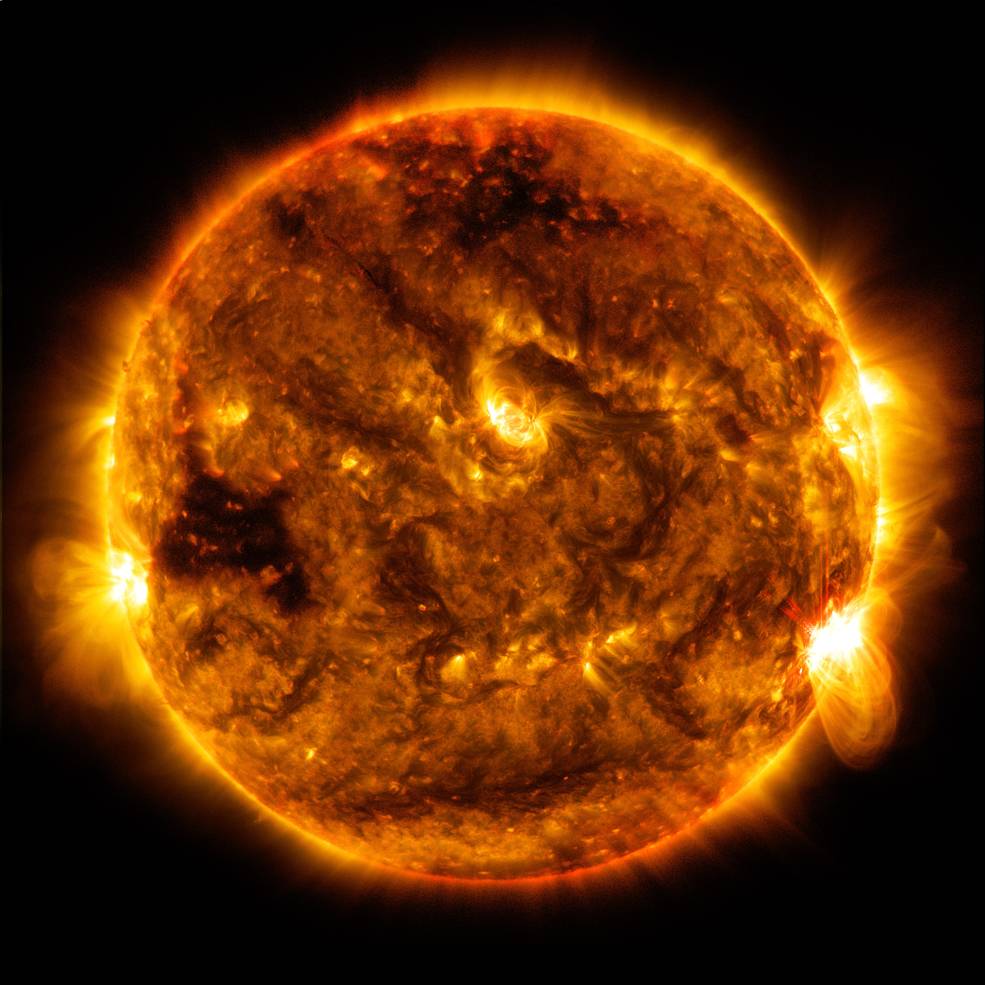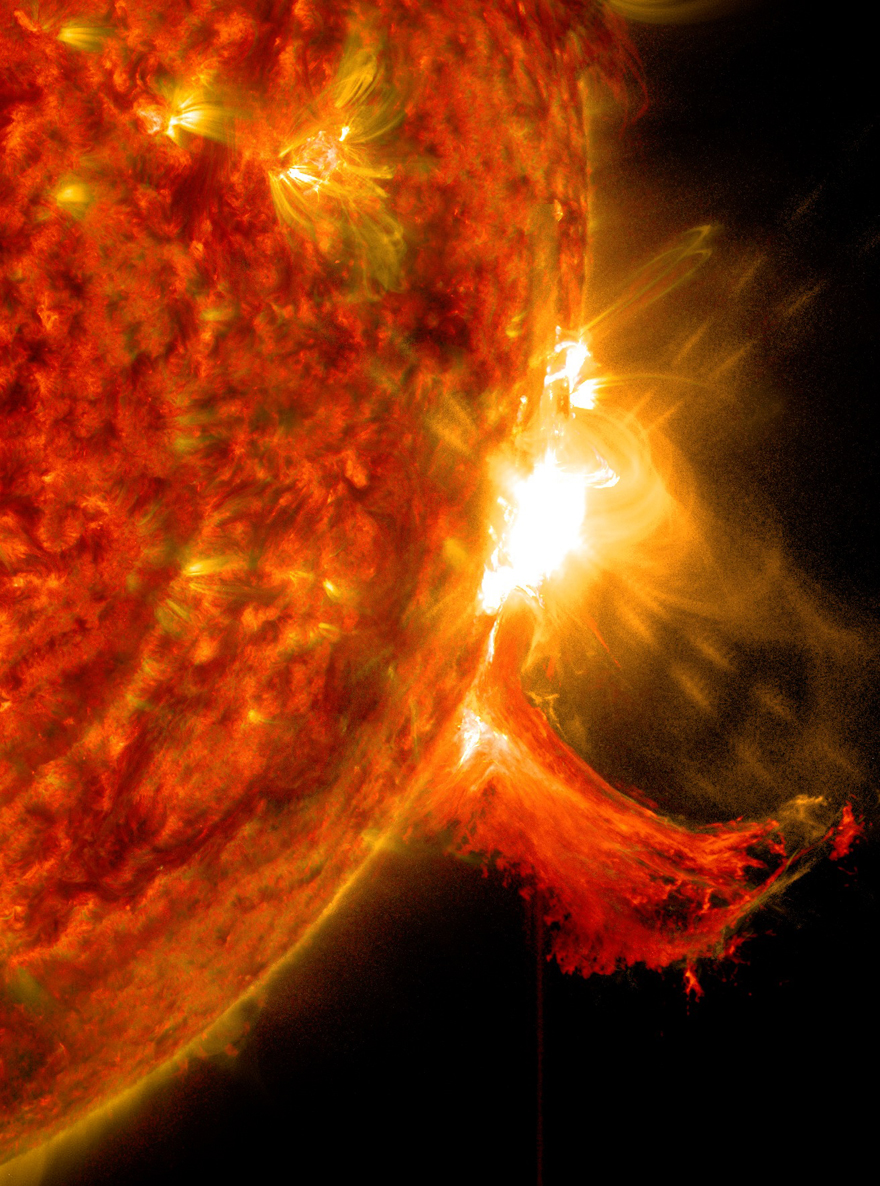The Sun
About the Sun
| Type | Star |
|---|---|
| Size (diameter) | 1.4 million km, or about 110 Earths |
| Mass | 2.0 × 1030 kg, or about 333,000 Earths |
| Orbital period | 250 million years |
| Orbits around | The centre of the Milky Way |
| Number of planets | 8 |
| Average distance from the centre of the Milky Way | 2.7 × 1017 km, or 27,200 light-years |
| Temperature | About 5500 degrees Celsius on its surface |

Credit: NASA/SDO
Life cycle
The Sun and the solar system were formed about 4.5 billion years ago when a giant cloud of gas and dust collapsed on itself. Since then, the Sun has continued to burn its fuel, hydrogen gas, and release particles and radiation (including light and heat!) out into the solar system.
In about five billion years, the Sun will run out of fuel and will swell up into a red giant star. It will become so large that it will swallow up Mercury and Venus – and possibly even Earth. Later on, the Sun will shed its outer envelope and leave behind a white dwarf, surrounded by an outer shell of gas. These glowing remains of Sun-like stars are called planetary nebulae.

The Ring Nebula (also known as Messier 57, its catalogue number) is a planetary nebula, the glowing remains of a Sun-like star after it has exhausted its fuel at the end of its life. (Credit: NASA/ESA/Hubble Heritage/Hubble Collaboration)
Measuring the universe: Light-years and solar masses
Distances between objects in space can be huge, so scientists have created new units to help express measurements on an enormous scale. Because all light travels at a constant speed of about 300,000 kilometres per second, it can be used to measure a light-year: the distance that light travels in one Earth year. That's about 9.5 trillion kilometres! The Sun is only about 150 million kilometres, or eight light-minutes, away from Earth.
Because the Sun is our closest and most well-understood star, astronomers use its characteristics as a reference when they study other stars. For example, the mass of gigantic celestial objects like black holes or galaxies is expressed in solar masses. The supermassive black hole at the centre of our galaxy is equivalent to about 4 million solar masses, and the Milky Way itself contains about the same mass as 1 trillion Suns – a thousand billion solar masses!
Orbit and rotation
The Sun orbits the centre of our galaxy, the Milky Way. It takes the Sun about 250 million years to complete one full orbit. Like the planets, it also rotates on its own axis. It takes a little over 25 days for the Sun to complete a full rotation.

Credit: NASA/Goddard
Structure
The Sun is made up of several layers that each have different characteristics.
The core:
- is the innermost part of the Sun
- has a temperature of over 15 million degrees Celsius
- is where nuclear fusion produces all of the Sun's energy
Energy from the core is transported outward through two layers called the radiative and convective zones.
The surface of the Sun has a temperature of about 5500 degrees Celsius.
The outermost region of the Sun's atmosphere, the corona, is hotter than the Sun's core. The corona can reach a scorching 20 million degrees Celsius, and scientists are still not sure why it is so incredibly hot. This outer layer can be seen during total solar eclipses.

A view of a mid-level solar flare captured in by NASA's Solar Dynamics Observatory. (Credit: NASA/SDO)
Space weather
The Sun's activity can have a significant impact on our daily lives. Powerful bursts, flares, and sudden increases in brightness can launch particles and radiation throughout the solar system. Solar storms are often associated with the beautiful aurora, as particles released by the Sun interact with Earth's magnetic field.
But these unpredictable events can also be dangerous – solar storms can trigger power outages, satellite malfunctions, and even disruptions to GPS and communications systems. The intensity of these storms is sometimes influenced by the Sun's seasons: our closest star goes through a cycle of minimum and maximum activity that lasts roughly 11 years. With each cycle, the Sun's north and south poles trade places.

A composite image of the Sun where each slice gives a view of the Sun in a different wavelength of light. (Credit: NASA/GSFC SVS)
Solar observation
Astronomers – amateur and professional alike – must use specialized equipment to observe the Sun because it is so incredibly bright.
Scientists have studied the Sun using space probes since the 1950s. NASA's Pioneer probes measured the Sun's winds and magnetic field. Launched in , the Solar and Heliospheric Observatory, built by NASA and the European Space Agency, provided constant direct observations of the Sun until . It continues to monitor the Sun at many different wavelengths.
NASA's Parker Solar Probe was launched in to study the Sun while in orbit around our star. As the probe makes its closest approaches to the Sun in late , it will achieve speeds of up to 200 km per second, making it the fastest artificial object. During its mission, the probe will graze the Sun's outer corona at a relatively close distance, only 7 million kilometres away! This flyby should help scientists solve the mystery of why the corona is much hotter than the surface. Parker will also study the Sun's magnetic field and collect data about energy and particles associated with solar winds.
